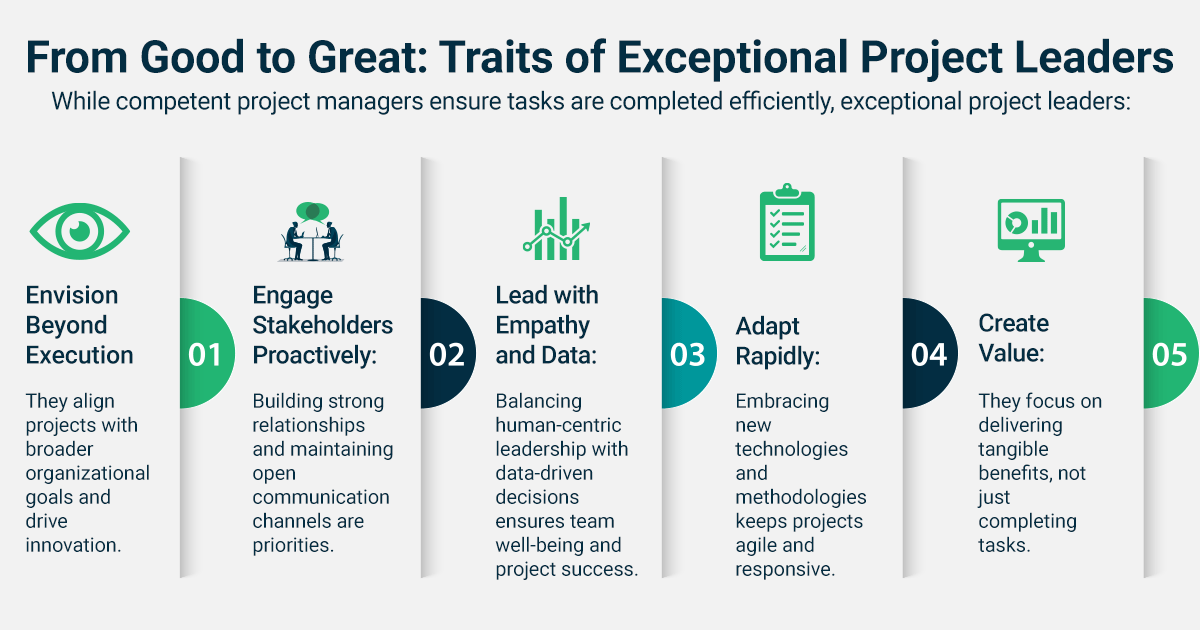
Quick Summary: In an era defined by complexity, speed, and strategic accountability, the role of the project manager is undergoing a radical transformation. Far beyond the confines of planning and delivery, project managers in 2025 are being redefined as hybrid leaders, balancing tactical rigor with visionary thinking. This article outlines how predictive intelligence is essential to modern project success. It equips professionals with real-time insights, stakeholder sentiment analysis, and early warning systems to mitigate risk before it escalates. As traditional models struggle under the weight of evolving scopes, remote teams, and limited resources, the rise of AI-powered solutions like TrueProject is ushering in a new paradigm—one where data augments decision-making, foresight replaces firefighting, and project managers are empowered not just to deliver, but to provide value.
In 2025, the business environment is characterized by rapid change, increased complexity, and heightened accountability. Project managers are at the forefront, ensuring that initiatives align with strategic goals and deliver value. Project management isn’t just a high-impact career—it’s a fast-growing one. According to the Project Management Institute, organizations worldwide must fill an estimated 2.3 million new project-related roles annually through 2030.
While "project manager" and "project leader" are often used interchangeably, they encompass distinct roles. A project manager focuses on planning, execution, and delivery, whereas a project leader emphasizes vision, influence, and team motivation. However, in many organizations, especially smaller ones, these roles overlap, requiring professionals to balance tactical and strategic responsibilities.
The emergence of predictive project management has further transformed the landscape. By leveraging data analytics and AI, project managers can anticipate challenges, optimize resources, and make informed decisions, enhancing project outcomes. Unsurprisingly, professionals from all backgrounds are eyeing the project management career path, whether through formal certifications or by growing into the role organically as "accidental project managers."
No matter your starting point, this guide will teach you everything you need to know to pursue a career in project management, with or without traditional credentials.
What is the Role of a Project Manager in 2025?
Project managers today do more than track deadlines. They enable cross-functional teams, manage stakeholder expectations, and ensure strategic alignment. Their daily tasks include risk assessment, resource allocation, and real-time decision-making. In contrast, project leaders focus on long-term goals, team motivation, and business impact. However, in smaller teams, these roles often merge. A project manager must think tactically while keeping strategic objectives in sight.
Key leadership traits for both roles include adaptability, emotional intelligence, and the ability to balance data-driven insights with human judgment. Let’s further understand the difference between project managers and project leaders.
Ready to stop reacting and start predicting? See how TrueProject empowers project managers to lead with confidence, clarity, and real-time insight. Book your demo now.

The Key Differences Between Project Managers and Project Leaders
Project leaders aren’t just focused on execution—they’re visionaries. Their role extends far beyond coordinating timelines or managing deliverables. They chart the strategic course, rally the team around a shared purpose, and spark motivation to achieve goals that often surpass expectations. Strongly emphasizing people skills, their leadership can drive innovation, transformation, and the development of new products, services, and systems. By staying closely involved and continuously motivating the team, project leaders empower individuals to become catalysts for change.
Let’s explore five core distinctions that set project managers and project leaders apart:
1. Project Managers Are Specialists; Project Leaders Are Big-Picture Thinkers
Project managers dive deep into the intricacies of execution. They focus on organizing workflows, managing risks, and ensuring the project stays on track. Their attention to detail and analytical approach are key to operational efficiency. Project leaders, on the other hand, operate at a broader level. They shape the overall vision, offering the team a compelling sense of purpose. Rather than managing processes alone, they guide people to perform at their best.
2. Leaders Design Strategy; Managers Tackle Operational Hurdles
While project leaders are strategic architects who shape long-term plans and inspire teams to pursue ambitious goals, project managers work with established frameworks. They handle unforeseen issues and pivot when necessary to keep everything aligned with the timeline and objectives.

3. Project Managers Prioritize Tasks; Project Leaders Prioritize People
Reaching milestones is essential to both roles, but project leaders go a step further. They focus on team growth and collaboration, building an environment where individuals are encouraged to excel. Their leadership fosters continuous improvement in both performance and team dynamics.
4. Leaders Inspire; Managers Direct
Project leaders lead with empathy, build trust, and connect personally with their teams. They aim to align individual aspirations with the project's goals to drive collective success. In contrast, project managers focus on delegation and supervision. They assign responsibilities based on immediate project needs and hold the authority to meet deadlines and quality standards.
5. Project Managers Maintain Stability; Project Leaders Drive Change
Project managers aim to preserve consistency across budgets, timelines, and resources. Their primary responsibility is to keep everything running smoothly within defined boundaries. Project leaders are more forward-looking. They challenge norms, encourage experimentation, and push the team to explore new methods for better results. Their mindset is rooted in innovation and continuous progress.
Both roles are essential to successful project execution, but serve different purposes. While project leaders focus on the big picture and inspire transformation, project managers serve as the driving force behind structured execution. To understand the full value they bring, let’s take a closer look at a project manager’s responsibilities across each phase of the project lifecycle.

What Does a Project Manager Do? A Look at Responsibilities Across the Project Lifecycle
A project manager plays a pivotal role throughout each project lifecycle, coordinating efforts with the team to ensure successful delivery. These responsibilities span five core phases, each demanding a unique blend of skills across integration, scope, time, cost, quality, human resources, communication, risk, procurement, and stakeholder engagement.
1. Initiation Phase: The project manager focuses on laying the foundation at the outset. This includes developing the project charter, which outlines the purpose, objectives, and scope. The manager is also responsible for identifying all key stakeholders who can influence or contribute to the project’s success.
2. Planning Phase: The planning phase begins once the project is approved. Project managers define the full scope, break it into manageable components using a work breakdown structure (WBS), and gather specific requirements. They create detailed schedules, map out activities, and estimate the resources and time needed for each task. This phase also involves cost estimation, budgeting, team planning, and crafting communication and quality control strategies. Risk management is critical—identifying potential threats, conducting risk assessments, and designing mitigation plans. Procurement needs and stakeholder engagement plans are also outlined at this stage.
3. Execution Phase: This is where the plans are put into motion. Project managers oversee the team’s work, ensuring all deliverables progress according to plan. They assemble and manage the team, maintain communication across all levels, initiate procurements as needed, execute quality management processes, and ensure alignment with stakeholder expectations.
4. Monitoring and Controlling Phase: While the project is in motion, managers track performance and adjust to keep it on course. This involves measuring project progress, implementing change controls, and verifying deliverables meet scope, cost, and quality benchmarks. Communication flow is actively managed, stakeholder involvement is monitored, and procurement activities are controlled to stay aligned with goals.
5. Closing Phase: At the end of the project, the manager ensures all aspects are formally concluded. This includes closing contracts, reconciling budgets, transferring deliverables to the client or end-user, and conducting lessons-learned sessions or post-project evaluations. Team members are released or reassigned, and final documentation is completed.
But even the most well-equipped project managers aren’t immune to disruption. Today’s fast-paced, unpredictable project environment presents new hurdles that can undermine even the best-laid plans. Let’s take a closer look at the challenges project managers are up against in 2025.
Is your project management approach built for today, or stuck in yesterday? Discover how forward-thinking leaders overcome modern challenges with predictive insights and real-time visibility. Learn more now.

Key Challenges Faced by Project Managers in the Current Landscape
The project management ecosystem in 2025 is more volatile and demanding than ever before. Organizations are running at an accelerated pace, yet are expected to deliver complex projects with pinpoint accuracy. Project managers deal with rapidly shifting challenges in this environment that test their operational depth and strategic foresight. Some of the challenges include:
1. Constantly Evolving Project Scopes: Project requirements today are rarely static. Project managers are expected to adapt instantly, whether a mid-project pivot due to market shifts or a late-stage change triggered by stakeholder feedback. But this flexibility comes at a cost—scope creep, resource drain, and timeline pressure. The traditional iron triangle of scope, time, and budget is under strain, and project professionals are often left playing catch-up without the right systems to anticipate or manage these changes proactively.
2. Remote and Hybrid Workforce Realities: Distributed teams are no longer a trend—they are the norm. Yet, managing collaboration, cohesion, and accountability in hybrid environments is a persistent struggle. Face-to-face alignment has been replaced by asynchronous communication, which can dilute urgency, reduce engagement, and delay issue resolution. For project leaders, maintaining visibility and trust across virtual teams requires new levels of coordination and clarity.
3. Resource Bottlenecks and Budget Constraints: Lean teams and tighter budgets are becoming standard operating conditions. According to PMI, 26% of project failures are attributed to resource dependency and 25% to scheduling conflicts. When human and financial resources are stretched thin, prioritization becomes a gamble, often made without the complete picture. Project managers are left making reactive decisions, trading off long-term value for short-term deliverables.

4. Stakeholder Engagement Gaps: Stakeholders want results but don’t always participate. Inconsistent feedback loops, unclear expectations, and delayed inputs make alignment difficult. Worse, when engagement happens late, it often derails previously aligned plans. Project managers must justify decisions retroactively or shift strategies, increasing the risk of missed deadlines and budget overruns.
5. Lack of Real-Time Project Visibility: Many organizations still rely on backward-looking metrics—status reports, time logs, or historical burn rates. This reactive approach masks emerging risks until it’s too late. Project leaders operate in the dark without real-time insights into project health, performance trends, and team sentiment. Decisions are delayed, warning signs are missed, and preventable risks snowball into costly crises.
These challenges are not isolated—they feed into each other, compounding pressure and reducing control. To rise above these compounding challenges, project managers need more than traditional tools and frameworks—they need foresight. That’s where predictive intelligence steps in, offering a smarter, proactive approach to project delivery. These solutions are equipped with AI and predictive analytics, provide real-time insights, automate routine tasks, and facilitate proactive decision-making.
The Power of Predictive Intelligence for Project Managers
A predictive project management solution combines AI and advanced analytics to transform scattered data points into forward-looking insights. It enables project leaders to avoid issues rather than respond to them. Instead of relying on post-mortem reports, the solution continuously analyzes project patterns, stakeholder interactions, team sentiment, and resource trends. It flags emerging risks before they become bottlenecks and helps leaders take corrective action while there’s still time.
When early warning signals detect deviations in project health—declining participation, mounting workload, or delayed stakeholder input—the solution delivers precise, actionable alerts. It doesn’t just show what’s wrong; it tells you where to focus and what to fix.
It also offers deep visibility into stakeholder dynamics by converting feedback into quantifiable sentiment trends. This insight allows project leaders to align communication better, reset expectations, and rebuild trust where it’s slipping. At the same time, the intelligent forecasting solution evaluates resource capacity and demand, clearly showing when and where constraints will likely occur weeks in advance.
According to Zepth, AI-powered success prediction models achieve 95% or more of intended business benefits in 69% of cases versus 53% for non-AI projects, underscoring the impact that data-driven decision support can have on project delivery. In environments where time and trust are non-negotiable, predictive intelligence moves leadership from reactive firefighting to intentional, strategic execution.
Importantly, the future is not about replacing judgment with algorithms. It’s about enhancing human insight with machine-augmented clarity. This synergy between technology and leadership allows organizations to move beyond gut instinct and isolated dashboards into a new era of precision and strategic alignment. As the demand grows to demonstrate ROI, justify investments, and link project outcomes to business impact, project managers must show they can deliver more than deliverables. They need to prove value. And that requires solutions that help them tell a data-backed story of success from the inside out.
Ready to lead with insight—not hindsight? Explore how TrueProject helps project managers turn data into foresight, and foresight into impact. Discover the future of project management.
When Strategy Meets Execution: The Future for Project Managers Starts Here
In today’s high-stakes, high-speed environment, being a project manager means far more than managing timelines and deliverables—it’s about driving clarity in chaos, aligning ambition with execution, and guiding teams through constant change with confidence. As predictive intelligence reshapes how we plan, track, and lead, project professionals have a unique opportunity to move beyond traditional roles and redefine what success looks like. That’s where TrueProject, a KPI-based predictive project management SaaS solution that improves project health and performance, steps in. With real-time insights, stakeholder sentiment analysis, and AI-driven early warning signals, TrueProject empowers project managers to anticipate risks, course-correct before issues escalate, and consistently deliver measurable results. Whether you’re stepping into the field for the first time or evolving from a tactical role into a strategic one, the future belongs to those who can connect vision with action, people with purpose, and data with decisions—and with TrueProject, that future is well within reach.
It’s time to lead projects with precision, not just intuition. See how TrueProject equips you to predict, prevent, and perform—before challenges turn into setbacks. Start your PM journey with TrueProject QuickStart.






